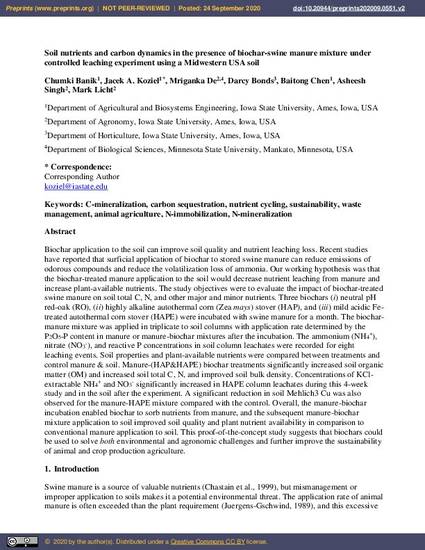
Biochar application to the soil can improve soil quality and nutrient leaching loss. Recent studies have reported that surficial application of biochar to stored swine manure can reduce emissions of odorous compounds and reduce the volatilization loss of ammonia. Our working hypothesis was that the biochar-treated manure application to the soil would decrease nutrient leaching from manure and increase plant-available nutrients. The study objectives were to evaluate the impact of biochar-treated swine manure on soil total C, N, and other major and minor nutrients. Three biochars (i) neutral pH red-oak (RO), (ii) highly alkaline autothermal corn (Zea mays) stover (HAP), and (iii) mild acidic Fe-treated autothermal corn stover (HAPE) were incubated with swine manure for a month. The biochar-manure mixture was applied in triplicate to soil columns with application rate determined by the P2O5-P content in manure or manure-biochar mixtures after the incubation. The ammonium (NH4+), nitrate (NO3-), and reactive P concentrations in soil column leachates were recorded for eight leaching events. Soil properties and plant-available nutrients were compared between treatments and control manure & soil. Manure-(HAP&HAPE) biochar treatments significantly increased soil organic matter (OM) and increased soil total C, N, and improved soil bulk density. Concentrations of KCl-extractable NH4+ and NO3- significantly increased in HAPE column leachates during this 4-week study and in the soil after the experiment. A significant reduction in soil Mehlich3 Cu was also observed for the manure-HAPE mixture compared with the control. Overall, the manure-biochar incubation enabled biochar to sorb nutrients from manure, and the subsequent manure-biochar mixture application to soil improved soil quality and plant nutrient availability in comparison to conventional manure application to soil. This proof-of-the-concept study suggests that biochars could be used to solve both environmental and agronomic challenges and further improve the sustainability of animal and crop production agriculture.
Available at: http://works.bepress.com/mark-licht/209/

This is a pre-print of the article Banik, Chumki, Jacek Koziel, Mriganka De, Darcy Bonds, Baitong Chen, Asheesh Singh, and Mark Licht. "Soil Nutrients and Carbon Dynamics in the Presence of Biochar-swine Manure Mixture Under Controlled Leaching Experiment Using a Midwestern USA Soil." Preprints (2020): 10.20944/preprints202009.0551.v2. Posted with permission.